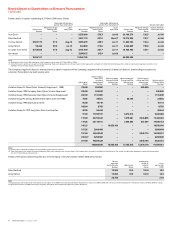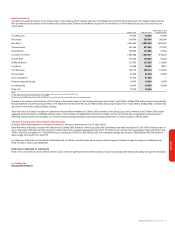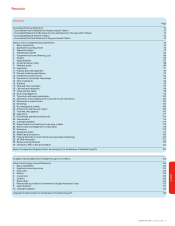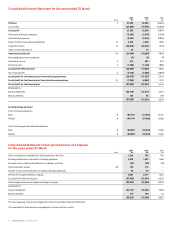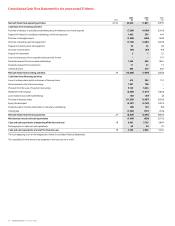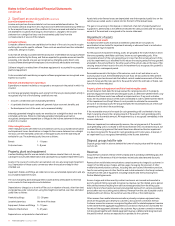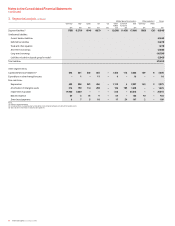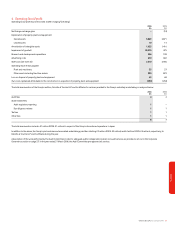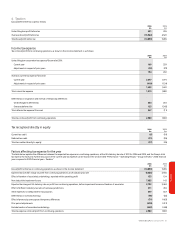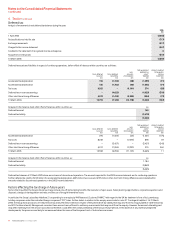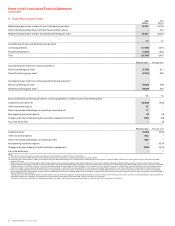Vodafone 2006 Annual Report Download - page 80
Download and view the complete annual report
Please find page 80 of the 2006 Vodafone annual report below. You can navigate through the pages in the report by either clicking on the pages listed below, or by using the keyword search tool below to find specific information within the annual report.
78 Vodafone Group Plc Annual Report 2006
Notes to the Consolidated Financial Statements
continued
levied by the same taxation authority on either the same taxable entity or on different
taxable entities which intend to settle the current tax assets and liabilities on a net basis.
Tax is charged or credited to the income statement, except when it relates to items
charged or credited directly to equity, in which case the tax is also recognised directly
in equity.
Financial instruments
Financial assets and financial liabilities, in respect of financial instruments, are
recognised on the Group’s balance sheet when the Group becomes a party to the
contractual provisions of the instrument.
The Group has applied the requirements of IFRS to financial instruments for all periods
presented and has not taken advantage of any exemptions available to first time
adopters of IFRS in this respect. The Group has early adopted IFRS 7, “Financial
Instruments: Disclosures”, amendments to IAS 39, “Financial Instruments: Recognition
and Measurement” and IFRS 4, “Insurance Contracts”, regarding “Financial Guarantee
Contracts” and amendments to IAS 39 regarding “The Fair Value Option” and “Cash Flow
Hedge Accounting of Forecast Intragroup Transactions” and applied them from 1 April
2004.
Trade receivables
Trade receivables do not carry any interest and are stated at their nominal value as
reduced by appropriate allowances for estimated irrecoverable amounts. Estimated
irrecoverable amounts are based on the ageing of the receivable balances and historical
experience. Individual trade receivables are written off when management deems them
not to be collectible.
Investments
Investments are recognised and derecognised on a trade date where a purchase or sale
of an investment is under a contract whose terms require delivery of the investment
within the timeframe established by the market concerned, and are initially measured at
cost, including transaction costs.
Investments are classified as either held for trading or available-for-sale, and are
measured at subsequent reporting dates at fair value. Where securities are held for
trading purposes, gains and losses arising from changes in fair value are included in net
profit or loss for the period. For available-for-sale investments, gains and losses arising
from changes in fair value are recognised directly in equity, until the security is disposed
of or is determined to be impaired, at which time the cumulative gain or loss previously
recognised in equity, determined using the weighted average costs method, is included
in the net profit or loss for the period.
Cash and cash equivalents
Cash and cash equivalents comprise cash on hand and call deposits, and other short
term highly liquid investments that are readily convertible to a known amount of cash
and are subject to an insignificant risk of changes in value.
Trade payables
Trade payables are not interest bearing and are stated at their nominal value.
Financial liabilities and equity instruments
Financial liabilities and equity instruments issued by the Group are classified according
to the substance of the contractual arrangements entered into and the definitions of a
financial liability and an equity instrument. An equity instrument is any contract that
evidences a residual interest in the assets of the Group after deducting all of its liabilities
and includes no obligation to deliver cash or other financial assets. The accounting
policies adopted for specific financial liabilities and equity instruments are set out below.
Capital market and bank borrowings
Interest bearing loans and overdrafts are initially measured at fair value (which is equal to
cost at inception), and are subsequently measured at amortised cost, using the effective
interest rate method, except where they are identified as a hedged item in a fair value
hedge. Any difference between the proceeds net of transaction costs and the
settlement or redemption of borrowings is recognised over the term of the borrowing.
Equity instruments
Equity instruments issued by the Group are recorded at the proceeds received, net of
direct issue costs.
Derivative financial instruments and hedge accounting
The Group’s activities expose it to the financial risks of changes in foreign exchange rates
and interest rates.
The use of financial derivatives is governed by the Group’s policies approved by the
board of directors, which provide written principles on the use of financial derivatives
consistent with the Group’s risk management strategy. Changes in values of all
derivatives of a financing nature are included within investment income and financing
costs in the income statement. The Group does not use derivative financial instruments
for speculative purposes.
Derivative financial instruments are initially measured at fair value on the contract date,
and are subsequently re-measured to fair value at each reporting date. The Group
designates certain derivatives as either:
•hedges of the change of fair value of recognised assets and liabilities (“fair value
hedges”); or
•hedges of net investments in foreign operations.
Hedge accounting is discontinued when the hedging instrument expires or is sold,
terminated, or exercised, or no longer qualifies for hedge accounting.
Fair value hedges
The Group’s policy is to use derivative instruments (primarily interest rate swaps) to
convert a proportion of its fixed rate debt to floating rates in order to hedge the interest
rate risk arising, principally, from capital market borrowings. The Group designates these
as fair value hedges of interest rate risk with changes in fair value of the hedging
instrument recognised in the income statement for the period together with the
changes in the fair value of the hedged item due to the hedged risk, to the extent the
hedge is effective. The ineffective portion is recognised immediately in the income
statement.
Net investment hedges
Exchange differences arising from the translation of the net investment in foreign
operations are recognised directly in equity. Gains and losses on those hedging
instruments designated as hedges of the net investments in foreign operations are
recognised in equity to the extent that the hedging relationship is effective. These
amounts are included in exchange differences on translation of foreign operations as
stated in the statement of recognised income and expense. Any ineffectiveness is
recognised immediately in the income statement for the period. Gains and losses
accumulated in the translation reserve are included in the income statement when the
foreign operation is disposed of. The Group has adopted the Amendments to IAS 21,
“The Effect of Changes in Foreign Exchange Rates”, with effect from 1 April 2004, being
the date of transition to IFRS for the Group.
Provisions
Provisions are recognised when the Group has a present obligation as a result of a past
event, and it is probable that the Group will be required to settle that obligation.
Provisions are measured at the directors’ best estimate of the expenditure required to
settle the obligation at the balance sheet date, and are discounted to present value
where the effect is material.
Share-based payments
The Group issues equity-settled share-based payments to certain employees. Equity-
settled share-based payments are measured at fair value (excluding the effect of non
market-based vesting conditions) at the date of grant. The fair value determined at the
grant date of the equity-settled share-based payments is expensed on a straight-line
basis over the vesting period, based on the Group’s estimate of the shares that will
eventually vest and adjusted for the effect of non market-based vesting conditions.
Fair value is measured using a binomial pricing model which is calibrated using a Black-
Scholes framework. The expected life used in the model has been adjusted, based on
management’s best estimate, for the effects of non-transferability, exercise restrictions
and behavioural considerations.
Advertising costs
Expenditure on advertising is written off in the year in which it is incurred.
2. Significant accounting policies continued


